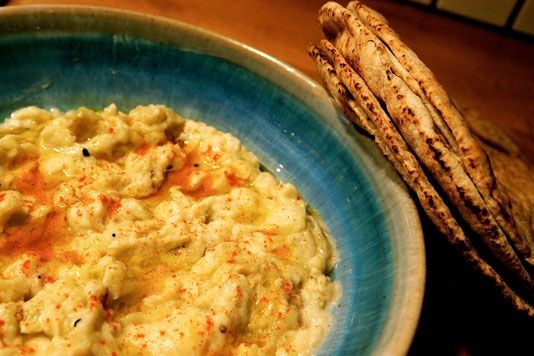
In the first of a new series about mezze of the Middle East, Mina Holland explores the story behind baba ganoush, a smoky celebration of the aubergine.
Baba ganoush is a dip made from smoked aubergine that’s been cooked over an open flame, and it is found ubiquitously across the Levant, North Africa and Turkey. Both Moorish and moreish, this mezze is a frequent precursor to an Arabic main course, drizzled with olive oil and eaten with flat bread.
Balance of flavours
The beauty of this dish lies in the delicate balance of flavours. Use too much of one strong ingredient – garlic, tahini, lemon juice – and you’ll upset it. That said, making baba ganoush successfully is as much about personal taste as anything else: everyone’s idea of this perfect balance is different. There are many variations, but as Greg and Lucy Malouf write in Arabesque, all the ingredients “should meld into one rich, creamy, smoky whole, which is infinitely greater than the sum of its parts.”
A breakfast of sorts
Though eaten all year round, baba ganoush is particularly popular during Ramadan, when Muslims are permitted to eat and drink once daylight fades. In this sense, baba ganoush is an Islamic breakfast - the dish of choice for “breaking fast”. Lebanese-Syrian chef and author Anissa Helou points out that baba ganoush is perfect for this purpose, smooth and easy on the stomach after so long without eating.
Helou told me, “Ramadan tables are always stocked with the same things before the daily orgy of eating. This varies from country to country, but during fast baba ganoush is particularly popular in Egypt, whereas in Lebanon we might be more likely to eat fattoush (Arabic salad) at night.”
What’s in a name?
Beloved by many, it's no surprise that ‘baba ganoush’ has the very poetic translation of ‘the darling of her father’ from Arabic. This isn’t the mezze’s only moniker, however. Elsewhere in the region, the smoked aubergine dip is called ‘moutabal’, which also translates elegantly to ‘seasons’ – perhaps an allusion to the different flavours that unite to form one delicious whole.
Whether there’s a difference between baba ganoush and moutabal is something of a grey area. Trawl the internet and it’s sometimes claimed that they have different ingredients – one with yoghurt, the other with pomegranate molasses – and so on. Other people, including Helou, say it is the same dish with two names. The general consensus seems to be that ‘baba ganoush’ originates from Lebanon while ‘moutabal’ hails from Syria.
Common Misinterpretation
Some recipes will tell you it is fine to bake the aubergines. It’s not! Anissa Helou, the Maloufs and Nigel Slater are all insistent about this, stating that blackening the aubergine over an open flame is by far the best way to get the intense smoked flavours the dish demands. Grilling the aubergines is also an option, but it is best to get them as close to a flame as possible. It will be harder to get that flavour if yours is an electric hob. Indeed, this is a fun recipe for any pyromaniacs out there.
Drain the juice
Helou also insists on draining the cooked aubergine flesh once the blackened skins have been removed. She says too much liquid both dilutes the lemony/sesame dressing and makes for a sloppy consistency.
When it comes to serving, I like to add a glug of extra virgin olive oil and a sprinkling of za’atar, a classic Middle Eastern spice mix. Some fresh pomegranate seeds make a lovely finish too.
See my baba ganoush recipe here.
More Middle Eastern treats
Jo Pratt's chilli and chickpea bites